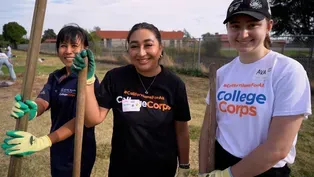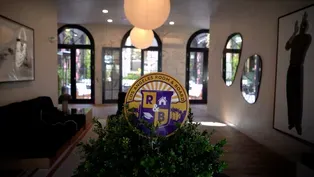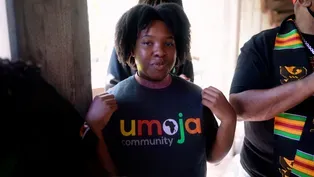Inside California Education
Aerospace Scholars: A NASA Learning Experience
Clip: Season 5 Episode 8 | 5m 50sVideo has Closed Captions
Meet Bay Area students taking part in a unique NASA experience.
Meet Bay Area students taking part in a unique NASA experience.
Inside California Education is a local public television program presented by KVIE
Funding for the Inside California Education series is made possible by the California Lottery, SchoolsFirst Federal Credit Union, Stuart Foundation, ScholarShare 529, and Foundation for the Los Angeles Community Colleges.
Inside California Education
Aerospace Scholars: A NASA Learning Experience
Clip: Season 5 Episode 8 | 5m 50sVideo has Closed Captions
Meet Bay Area students taking part in a unique NASA experience.
How to Watch Inside California Education
Inside California Education is available to stream on pbs.org and the free PBS App, available on iPhone, Apple TV, Android TV, Android smartphones, Amazon Fire TV, Amazon Fire Tablet, Roku, Samsung Smart TV, and Vizio.
Providing Support for PBS.org
Learn Moreabout PBS online sponsorship♪♪♪ Sergio: It's been a really good experience that I'm still learning from, and I'm probably going to take these skills elsewhere.
Narr: Sergio Gonzalez is a student at Contra Costa Community College who's enrolled in an out of this world opportunity.
When I heard the NASA, I thought it'd be a good opportunity not only to challenge myself a bit with the group work, since I'm not too keen on it, but also to kind of expand the opportunities I already have.
Narr: It's called the NASA Community College Aerospace Scholars Program, or NCAS.
The one at this college in San Pablo is part of a nationwide program offering a blended learning opportunity, a five week online course, and an exclusive NASA experience where the students gain insight into NASA's unique missions and diverse workforce.
They also get access to world class NASA facilities.
Jon: The goal of the program is really to broaden a student's perspective on both themselves and the potential fields they could go into.
It's an extraordinary opportunity.
Narr: Jon Celesia is the dean of Astronomy, Physics, Engineering and Computer Science, who helps oversee the NCAS program and was instrumental in bringing the program to the college.
Jon: It's a long time coming, and we... we are so happy to bring it to the community.
Narr: Contra Costa College is one of only seven community colleges in California chosen by NASA and is the only Northern California campus to offer the program.
A majority of the students are taking STEM classes focused on science, technology, engineering and mathematics.
It's designed to guide students in developing their talents, interests and passion to pave the way to a future specializing in one or more of those skills.
Students: Oh!
Oh!
Narr: The final portion of the program involves an engineering design challenge where the remaining students are divided into four teams.
Teacher: So close!
So close... Jon: Each team is a company and they are trying to get NASA to use them to build this part to go to Moon or Mars.
Narr: The teams compete against each other using Legos to build model NASA Rovers.
Jon: There is the hands on of the actual putting together the robot and modifying it.
There's the hands on of the programing, the robot to do whatever in the testing and they've got certain tasks to achieve.
So it takes a dedication.
Sergio: Yeah, I would say we only got like about 36 hours within the span of four days.
So it was a bit of a time constraint on us, but it was something that did push us to the point where we were able to do it and we were able to find ways of solving the issues we had.
Jon: They're learning real life skills.
There's communication, there's planning, there's working together with different types of people, delegating responsibilities.
So now they're learning to be on a team.
Sergio: I mostly spend time building and designing the robot and coding it.
I've never actually had a coding position, so working in such a manner, it was interesting because I thought, maybe I can't really do it yet, but seeing now that I am capable of it, I'm just...
I just needed to learn to push myself.
Maria: I didn't know what I was getting into and it was grueling... but it was so worth it.
Narr: Unlike the other STEM students, Maria Suwabe is pursuing an education in early childhood development.
So why did she enroll in this program?
Maria: I'm an early childhood educator, so I was like, okay, I want to do it for my kids.
Why not?
If I'm going to be a teacher, I better go and train myself first before I teach the children.
Student: Oh!
Wait!
Oh no!
Jon: I think what's really important is that one can easily think of scientists in general or NASA people as a bunch of geniuses.
I think that really breaks that barrier.
It's... it's about showing up.
It's about hard work.
It's about passion.
Maria: I feel very fortunate to have taken it here.
I hope that I can inspire other people to come and try it.
Don't be afraid of it and just go for the program.
Its... really, really, really, really exciting to be in it.
Sergio: At the end of the day, everyone did win something because we got the experience out of it.
Jon: It's more than a robotic competition.
It's touching them deeper than... than that.
It's almost been surprising to see just how much it's affected them It's one of those things where if you do climb a mountain, it's hard and every step can be challenging, especially near the end but... but they need that perseverance to say, “you know, I'm going to as long as it takes and we're going to get it done.
I'm going to look back at the mountains and say that I climbed it.
” Narr: What does it take to become an astronaut?
Since the 1960s, NASA has only selected 350 people to train as astronaut candidates to explore space.
The basic requirements include: United States Citizenship, Master's degree in a STEM field, two years of related professional experience, 1000 hours of pilot-in-command time in a jet aircraft, must pass the NASA's long duration space flight physical, which includes requirements such as visual acuity correctable to 2020 in each eye.
College Corps: Reducing Debt through Community Service
Video has Closed Captions
See how California students can reduce their student loan debt through College Corps. (5m 7s)
From Homeless to Housed in Los Angeles
Video has Closed Captions
Community college students in Los Angeles go from homeless to housed. (6m 7s)
Video has Closed Captions
Discover how Umoja is creating community on community college campuses. (4m 55s)
Providing Support for PBS.org
Learn Moreabout PBS online sponsorshipInside California Education is a local public television program presented by KVIE
Funding for the Inside California Education series is made possible by the California Lottery, SchoolsFirst Federal Credit Union, Stuart Foundation, ScholarShare 529, and Foundation for the Los Angeles Community Colleges.














